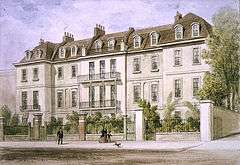Lindsey House
| Lindsey House | |
|---|---|
 An 1850 watercolour of the house by Thomas Hosmer Shepherd | |
| General information | |
| Type | Town house |
| Location |
Cheyne Walk London, SW3 United Kingdom |
| Completed | 1674 |
| Client | Robert Bertie, 3rd Earl of Lindsey |
| Owner | National Trust |
| Designations | Grade II* listed |
Lindsey House is a Grade II* listed villa[1] in Cheyne Walk, Chelsea, in the Royal Borough of Kensington and Chelsea. It is owned by the National Trust but tenanted and only open by special arrangement.
This house should not be confused with the eponymous 1640 house in Lincoln's Inn Fields. That house came to be known as Lindsey House for its occupation in the 18th century by later Earls of Lindsey.[2]
History
The house was built in 1674 by the third Earl of Lindsey[3] on the riverside site of Thomas More's garden and is thought to be the oldest house in Kensington and Chelsea.[4] It was extensively remodelled in 1750 by Count Zinzendorf for the Moravian community in London.
The house was divided into four separate dwellings in 1775. Today, it occupies nos. 96 to 101 of Cheyne Walk, covering a number of separate frontages and outbuildings.[1] Previous residents have included the historical painter John Martin, in one of the outbuildings at 4 Lindsey Row from 1849–53 and James McNeill Whistler between 1866–78 at 2 Lindsey Row (now 96 Cheyne Walk).[5] In 1808, engineer Marc Brunel lived in the middle section of the house (now no. 98), and his son Isambard Kingdom Brunel grew up here.[4] These residencies are commemorated by Blue plaques on the walls of the house.[1]
The house was separated from the river by the construction of the Chelsea Embankment, completed in 1874, as a part of Joseph Bazalgette's grand scheme to create a modern sewage system.
One part of the house features a garden designed by Edwin Lutyens and Gertrude Jekyll in 1911. This is a small garden of 50 feet (15.2 m) by 30 feet (9.1 m), laid to grass, two broad paths with two narrow paths on the boundary run the length of the garden around an ancient mulberry tree and lily pond. This area is surrounded by statuary, a colonnade and a single flower border. The garden is said by Lennox-Boyd be "modest in its elements, quietly restful in its effect" and "to respect the simple formality of the house".[3] In 2000, the garden was restored and a glazed garden room was added to the house by Marcus Beale Architects.[6]
See also
- Carlyle's House is a nearby NT property in Cheyne Row
References
- 1 2 3 Historic England. "Details from image database (203685)". Images of England. Retrieved 24 May 2008.
- ↑ Lincoln's Inn Fields: Nos. 59 and 60 (Lindsey House), Survey of London: volume 3: St Giles-in-the-Fields, pt I: Lincoln's Inn Fields (1912), pp. 96-103] accessed: 22 May 2008.
- 1 2 Private Gardens of London – Lutyens Revisted Arabella Lennox-Boyd
- 1 2 Lindsey House Royal Borough of Kensington and Chelsea archives accessed 22 May 2008
- ↑ Settlement and building: Artists and Chelsea, A History of the County of Middlesex: Volume 12: Chelsea (2004), pp. 102-106 accessed: 22 May 2008.
- ↑ Projects:Lindey House Marcus Beale architects accessed 24 May 2008
Bibliography
- The Story of Lindsey House, Chelsea Peter Kroyer
External links
- "Lindsey House". National Trust. 2006. Archived from the original on 2006-11-13. Retrieved 2012-09-25.
-
 Media related to Lindsey House at Wikimedia Commons
Media related to Lindsey House at Wikimedia Commons
Coordinates: 51°28′56″N 0°10′28″W / 51.4822°N 0.1745°W